Russia/Soviet Union
The history of Russia’s national bibliography has been described in detail in a number of sources. For an overview of its very complex history in the twentieth century see Sorok let Sovetskoi Gosudartvennoi Bibliografii (1920-1960) (Moscow: Vsesoiuznaia Knizhnaia Palata, 1960) or Thomas Whitby and Tanja Lorkovic’s Introduction to Soviet National Bibliography (Littleton, CO:Libraries Unlimited, 1979). For the prerevolutionary period N. V. Zdobnov’s article “Gosudarstvennaia bibliograficheskaia registratsiia pri tsarizme” (Sovetskaia bibliografiia, No. 4, 1935, pp. 75-96) provides an excellent discussion of the depository law and the development of Russia’s national bibliography in the nineteenth century.
One general source that can be of assistance when dealing with Russian bibliographies is Bibliotechnoe delo: terminologicheskii slovar’. (Moskva, 1986) U of I Library call number Main Stacks 020.39171 B471. In those cases where the Russian/Soviet bibliographic terminology is unclear this work is often helpful.
The sources included in this section are those that were really intended as comprehensive listings of Russia’s publications. Such a definition for national bibliography will include some sources that were not official government publications for certain periods. After the establishment of the depository law in 1837 which mandated that a copy of each published work be reviewed by official censors, those same censors began creating lists of all published materials which were issued in a series of publications. This section tries to list those publications, official and otherwise, that were attempting to create comprehensive lists of Russia’s publishing output.
Online Resources
General’nyi alfavitnyi katalog knig na russkom iazyke (1725 – 1998)
URL: http://www.nlr.ru/e-case3/sc2.php/web_gak
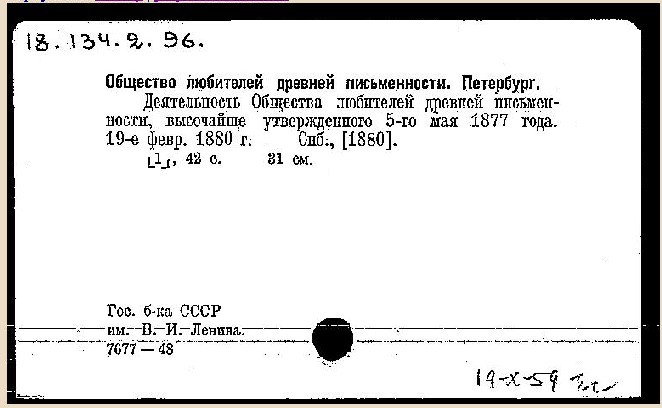
This is the online version of the card catalog of the National Library of Russia in Saint Petersburg, listing books published between 1725 and 1998. Since this is one of the largest collections in Russia and was a depository library during the tsarist and Soviet regimes it is a fairly comprehensive listing of Russia’s publications. As can be seen in the example above, the cards have been scanned and are arranged by author, or if there is no author, by title. To search the catalog, you enter the author’s name, using Cyrillic characters. The search result will be a list that places you near the record you need. Often you will have to search through several cards, but the records load quickly. The difficulty is worth the tremendous advantage of having access to this catalog.
This catalog is also available on microfiche. In this format the catalog has several supplements of special interest to the scholar including the entries for the 1.5 million items in the National Library in the languages of the minorities of the FSU. These include catalogs for : Ukrainian, Belorussian, Latvian, Lithuanian, Estonian, Bashkir, Tatar, Chuvash, Azeri, Kyrgyz, Turkmen, Kazakh, Tajik and Uzbek. Another important feature of the fiche version is the serials supplements which lists the serials holdings of the National Library.
Russkaia kniga grazhdanskoi pechati XVIII v., 1708-1800.
URL: http://www.nlr.ru/rlin/ruslbr_v2.php?database=RLINXVIII
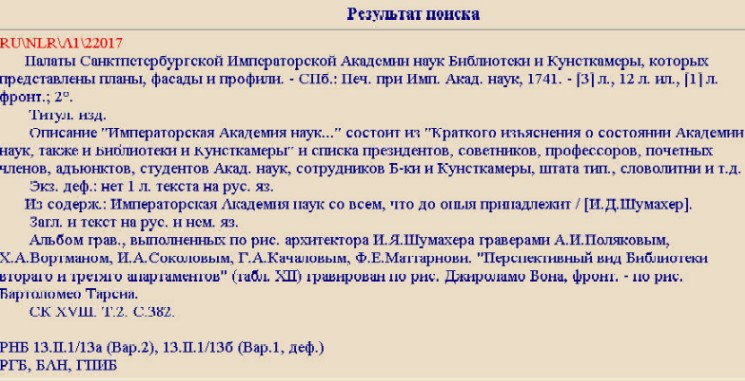
This catalog records Russian publications issued during the eighteenth century. This is a very easy catalog to search. The only obstacle the user may face is the fact that it must be searched using Cyrillic characters. All fields, that is, author, title, subject, language, organization, year of publication and holding institution can be searched. Anyone planning a research trip to Russia with an interest in the eighteenth century will find this a very valuable resource indeed. It lists holding institutions in Russia. Also, much of this material is held in the United States as the result of a long standing microfilm project to film Russian eighteenth century publications. Each of the records includes the reference number for this film after the annotation for the item. The reference number is in the form SK XVIII T.# S#. The SK refers to the Svodnyi Katalog Russkoi Knigi XVIII (Tom 1-5. Moscow: Izdanie Gosudarstvennoi Biblioteki SSSR im. V. I. Lenina. 1962-).While the project is not yet complete, it is worth checking with libraries here when trying to identify a library that holds a title from this period.
Russian National Library
URL: www.nlr.ru
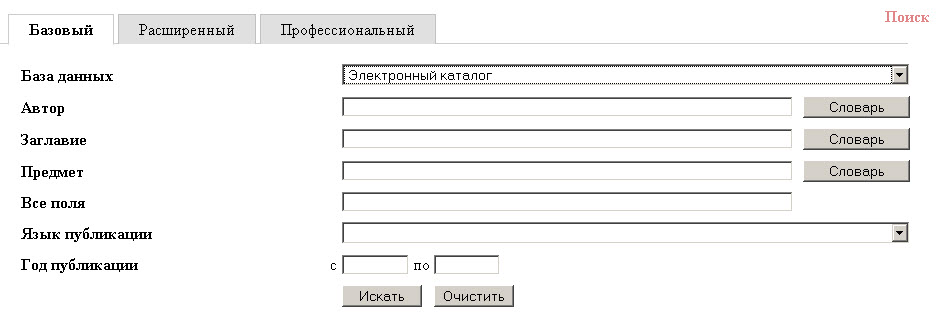
This online catalog includes titles added to the library since 1998. It includes materials newly acquired by the library.There is a separate database of materials published by and about the library at this same site. There are actually several databases here. The first is the catalog of Russian books obtained since 1998. The second is a catalog of dissertations acquired since 1996. The third that is listed as part of the “Elektronnyi Katalog” is a catalog of cartographic materials acquired since 1994. The catalog must be searched in Russian using Windows Cyrillic (CP 1251). The search is a keyword search. It is possible to search at several levels of complexity here. The basic search is a simple, single field search. The image above displays the options available from an advanced search – the middle level. As can be seen here all fields are searchable and all must be searched using Cyrillic characters. An expert search is also available. The citations that are returned provide full bibliographic information for each title.
Russian State Library
URL: www.rsl.ru
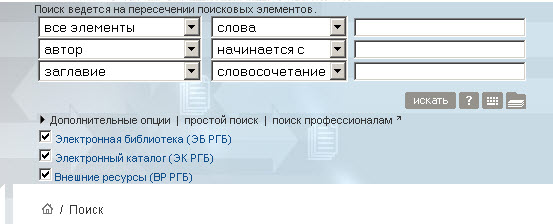
This catalog includes publications obtained by the Russian State Library after 1994-. Books, journals, dissertations, and cartographic materials in Russian and foreign language are all registered here. The books catalog can be searched by author, title, keyword, subject, year or place of publication. Like the National Library Catalog, this one is divided into several databases. The State Library has a catalog of books, including foreign language publications from 1986 on and Russian language books from 1994 on. The catalog of journals includes materials from 1998 on. This catalog has both newspapers and periodicals. The dissertation catalog contains complete dissertations from 1995 and avtoreferaty from 1987. The catalog of cartographic materials includes materials from 1985 on. There is also a catalog of the most recent acquisitions of the library, those materials acquired during the last week.This catalog is not searchable in the usual way, but is organized by subject and is easy to browse by subject.
Searches will return full bibliographic information on a title. Librarians will find the MARC format option useful.
Bibliographies
Svodnyi katalog Russkoi knigi Grazhdanskoi Pechati XVIII veka
1725-1800 . V.1-5 + Supp. Moscow: Izdanie Gosudarstvennoi Biblioteki SSSR im. V. I. Lenina. 1962-
U of I Library Call Number: International & Area Studies Russian Reference (Slavic) and Main Stacks 015.47 Sv51, v.1-5, supp.
While this is not a national bibliographic source in the same sense as Knizhnaia letopis’ it is an essential resource for anyone looking for a record of the material published in Russia during the eighteenth century. To see a more complete annotation click on the title above.
Ukazatel’ vnov’ vykhodiashchikh knig [ianvar’ 1837-iiun’ 1855].
Zhurnal Ministerstva narodnogo prosveshcheniia . Spb., 1837-1855.
U of I Library Call Number: History, Philosophy, & Newspaper FILM 027.247 G28u
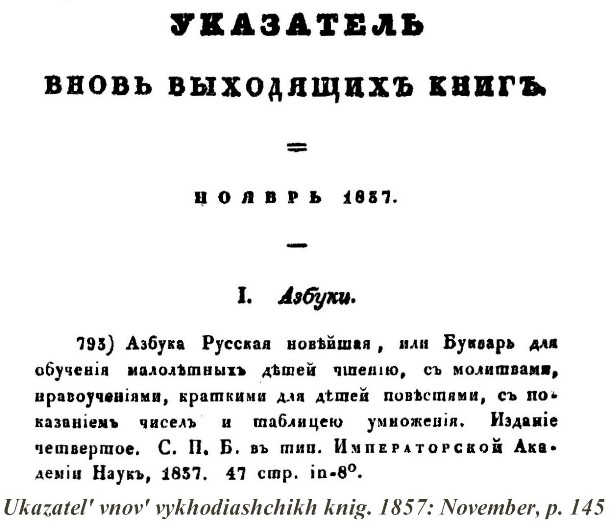
This was the initial source for the publication of the censors lists and thus served as the original location for the most comprehensive list of Russia’s publishing output. Initially, these lists were organized by subject and did not have an author or title index.. This publication was issued as a supplement to the Zhurnal Ministerstva Narodnogo Prosveshcheniia under various titles (1839-1843: “Bibliograficheskie pribavleniia”; 1844-1848: “Otdelenie bibliograficheskoe”; 1849 – : “Bibliograficheskie pribavleniia k Zhurnaly Ministerstva narodnogo prosveshcheniia” ). The frequency varied as well with the list being issued anywhere from four times to thirteen times annually. A total of 21, 898 entries/numbers were listed in this source. Sokurova’s discussion of this source gives the issue numbers in which the bibliographies were published and the number of items listed annually.
The bibliography included books, brochures, music, maps and some irregularly published serials in Russian and other languages, published within the borders of the Russian Empire. Titles in the list were organized under the following subject categories: grammar; children’s books; linguistics, literature; history, archaeology; geography; political science; astronomy; art; military science; agriculture; technology; medicine; Jewish books and books in Western languages (from 1851 on).
Russkii bibliograficheskii ukazatel’ za 1855 god.
Pribavlenie k Izvestiiam Akademii nauk po Otdeleniiu russkogo iazyka i slovesnosti, 1856, T. 5
OCLC: 137630087
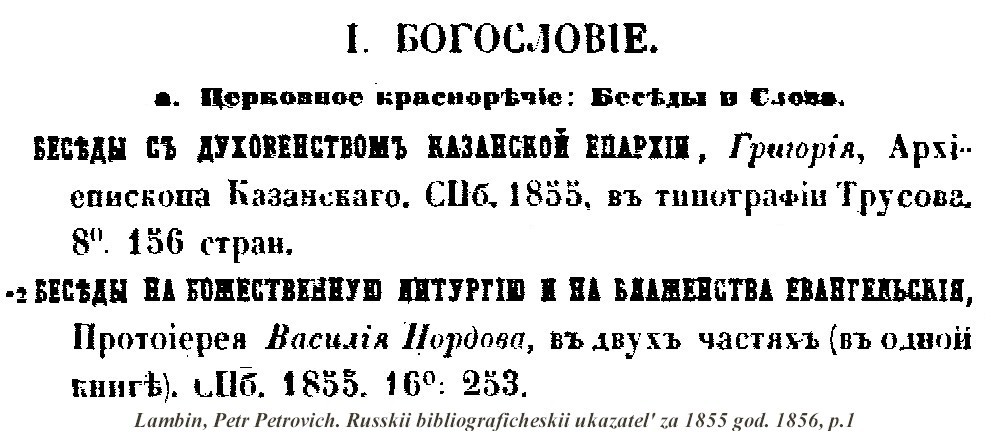
Lambin compiled his bibliography from the material obtained by the Russian Academy of Sciences. His bibliography includes books, off-prints, maps and periodical publications, some 998 items. Some of records include references to reviews. The bibliography is organized by subjects: religion, law, politics, geography, history, linguistics, literature, mathematics, natural sciences, medicine, hydrography, astronomy, military science, art, periodical publications and Russian books published abroad. The bibliography includes an author/translator/publisher index.
Bibliograficheskii ukazatel’ izdannykh v Rossii: knig, otdel’nykh listkov estampov, not, kart, planov i proch., i postupivshikh v imp.
Mezhov, Vladimir Izmailovich. Otechestvennykh zapisok, 1856:5-12; 1857:1,4,7,10; 1858:1.
U of I Library Call Number: International & Area Studies Microform (Slavic) MFICHE 057 OT 1839-1884
Bibliograficheskii ukazatel’ knig, broshiur i periodicheskikh izdanii vyshedshikh v Rossii v techenie ….
Mezhov, Vladimir Izmailovich. Prilozhenii k Zhurnal Ministerstva vnutrennikh dIel, 1860:2-4,9,12;1861:2,5,6
U of I Library Call Number: International & Area Studies Microform (Slavic) Mfiche 947.07 R9212Z, 1860, 1861
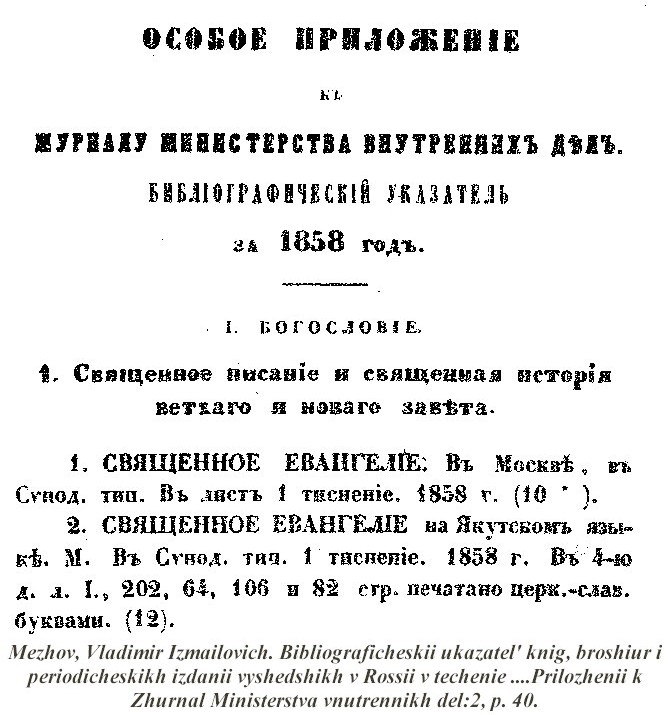
While these bibliographies appeared in two different periodicals, both were based on the collection in what is now the Russian National Library in St. Petersburg.
For 1856-1857 Mezhov published his lists in Otechestvennye zapisk i. These bibliographic lists included Russian and foreign language publications in a systematic index. More than 4,000 items were listed here including periodical titles. In 1857, Mezhov included reviews with the entries for some books. Materials were organized into eight categories: books and brochures; pamphlets; engravings and lithographs; children’s games; patterns for women’s clothing; atlases, maps and plans; manuscripts and music. The books section was further subdivided by subject to include the following areas: religion, education, law, geography, history, linguistics, children’s books, literature, philosophy, art, math and astronomy, natural sciences, medicine, military science, industry, books in the Jewish language and books in western languages. All entries supplied complete bibliographic information including place of publication, typographer, year of publication, extent, illustrations, and series statements, where appropriate. An alphabetical index of authors was included for the books sections.
Sokurova describes these lists as the most complete indexes of new books for the period.
The bibliographies for 1858-1859 were published as supplements to the Zhurnal Ministerstva Vnutrennykh Diel. Here some 4,583 entries were included including periodical publications for the time. Mezhov used the same organizational system as described above. Some entries for collections included a listing of their contents. Like the bibliographic lists published in Otechestvennye zapiski, these lists were the most complete record or publishing in Russian for the period.
Bibliografiia [novykh knig].
Knizhnyi viestnik ., Spb.:1860-1867
U of I Library Call Number: History, Philosophy, & Newspaper Film 016.891705 KN, 1860-1867
![sample entry for Bibliografiia [novykh knig]](/wp-content/uploads/sites/21/media/nationalbib/images/kv186310.jpg)
For seven years, Knizhnyi viestnik was the source for the most complete listing of new publications in Russia. Like the lists produced in Otechestvennyie zapiski and Zhurnal Ministerstva vnutrennykh die l it was compiled from the holdings at the Publichka, now the Russian National Library, in St. Petersburg. The bibliography had several editors, beginning with Mezhov and Fel’dt. Others included A.A. Stoikovich, N. S. Kurochkin, N. D. Nozhin and N. K. Mikhailovskii.
Citations in the bibliography included the authors full name, the place of publication, the typographer and year of publication, extent, illustrations and format. There are indexes for each year but they vary in content. Knizhnyi Viestnik also published statistical tables on Russian publishing between 1864 and 1866 in the following issues: 1864:24, 1865:11, 12, 22, 23; 1866:3.
Spisok izdanii, vyshedshikh v Rossii. [Ianvar’ 1869 – oktiabr’ 1876; ianvar’ 1879 – dekabr’ 1902]
Pravitel’stvennyi viestnik. Spb., 1869-1876, 1879-1903.
U of I Library Call Number: History, Philosophy, & Newspaper FILM 947.08 P891 (1869-1917)
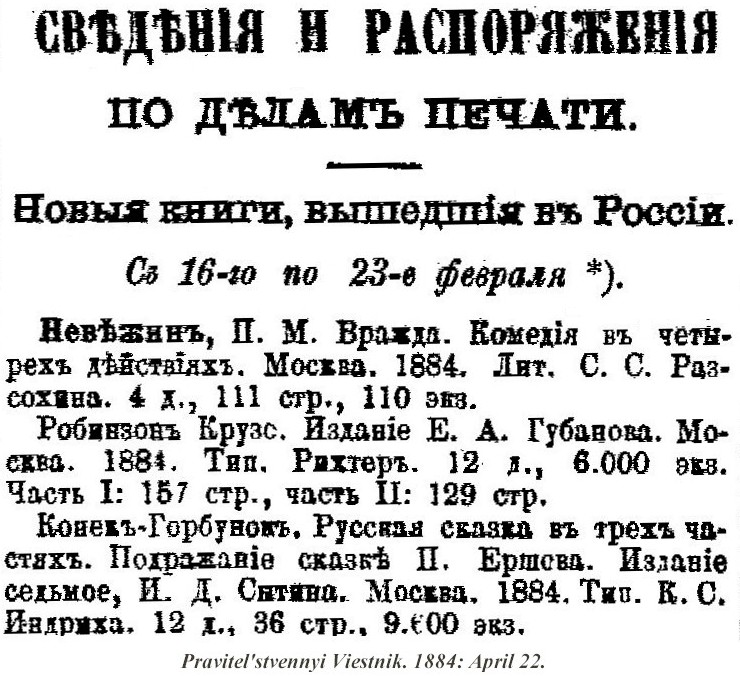 For much of the latter part of the 19th century the censors lists were in essence the national bibliography. As can be seen from this example from Pravitel’stvennyi viestnik (1884: April 22) the publication information included here was complete but the lack of any alphabetical order to the entries makes this a particularly difficult source to use. It is a source of last resort when no other source of verification is available.
For much of the latter part of the 19th century the censors lists were in essence the national bibliography. As can be seen from this example from Pravitel’stvennyi viestnik (1884: April 22) the publication information included here was complete but the lack of any alphabetical order to the entries makes this a particularly difficult source to use. It is a source of last resort when no other source of verification is available.
The lists were included in numerous issues, although the title of the column changed periodically. The inclusion of the tirazh can be useful for those looking for the readership of certain titles. The list included all types of non-periodical publications that had been reviewed by the censors: books, brochures, maps, music, tables and pamphlets. Basically anything published in the borders of the Russian empire, regardless of language was included in this list.
Spisok knig, vyshedshikh v Rossii… [1884-1907] .
Pechatano po rasporiazheniiu Glavnogo Upravleniia po delam pechati. Spb, 1884-1908. .
U of I Library Call Number: Oak Street Facility 015.47 R92s 1886-1906 [U of I Library lacks 1901 and 1902.]
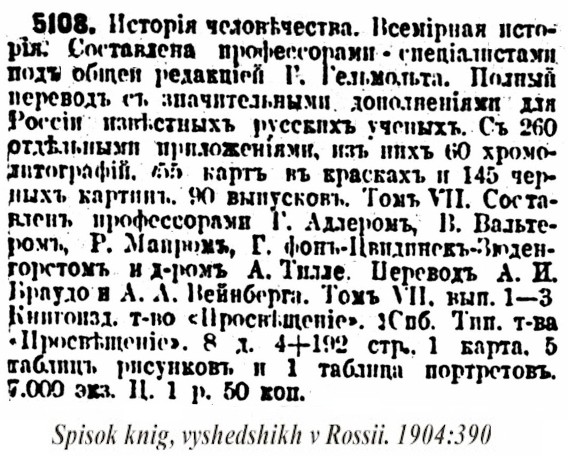
This was the official list of the censors issued by Kantseliariia Glavnogo upravleniia po delam pechati. Until 1902 it was basically an offprint of the censors’ lists published in Pravitel’stvennyi viestnik and bound together in annual volumes.What this means for the users is that the bibliography consists of weekly lists that have been bound together with no index and with only alphabetical arrangement for each week. Difficult to use at best.
From 1903 through 1907 the publication improved its organization. In 1903 the entries were arranged in one alphabetical list with foreign language publications grouped by language in the back of the volume. 1904 saw the introduction of an author index, which was included in all volumes through 1907.
The items listed in this publication repeat all the errors from the original censors lists. In July of 1907, a new publication began to be issued to replace the Spiski. That publication continues today under its original title Knizhnaia letopis’.
Given the difficulties of using these lists it is rare that a scholar will consult them. Particularly, since the scanning of the card catalog of the Russian National Library one can most often find a published source more readily either at the website of the library or, if your library holds the microfiche, by consulting the film version of this source.
Knizhnaia letopis’.
Moscow: Vsesoiuznaia knizhnaia palata.1907-
U of I Library Call Number: Main Stacks Reference 015.47 K749; History, Philosophy & Newspaper FILM 015.47 K749, 1907-
Any publication that survives as long as Knizhnaia letopis’ is bound to go through many changes. The name of the issuing body and the periodicity have varied over time. What has not changed is the essential purpose of the publication. Knizhnaia letopis’ remains a national bibliography which attempts to record as much of Russia’s printed intellectual history as possible. Since the fall of the Soviet Union this has become significantly more difficult. There is no longer a depository law that can be enforced. During the Soviet era the elaborate censorship system guaranteed that most titles would be included in the publication. Since the dissolution of the U.S.S.R. the situation has changed. Publishers often print books with extremely small print runs and do not send “depository” copies to the national library. Thus, it is no longer possible for the Russian State Library to obtain everything published on Russian territory.
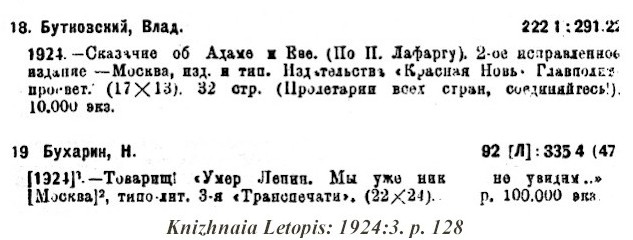
There are already excellent descriptions of this source that in Sokurova, Gosudarstvennaia Bibliografiia SSSR. Spravochnik (Moscow: Kniga, 1967) and other resources. The discussion here is intended to assist the scholar in its use.
One of the most important features of the bibliography is its subject organization which was begun in 1925. Up to that point, the entries were arranged alphabetically by author or title as had been the pre-revolutionary bibliographies. The subject headings have gone through many changes over the years, all of which are described in Sokurova (pp.193-196). Since that description appeared the subject headings have been revised several times. Why is this of any importance for the researcher? The variations in the subject organization affect the researcher’s access to materials. Knizhnaia letopis’ is also available as an e-resource which can be found here.
| Subject Headings 1972(#8) -1977 | Subject Headings 1978(#20) -1992 | Subject Headings 1993- Based on Universal Dewey | |
|---|---|---|---|
| 1 |
1. Markzism-leninizm
|
1. Markzism-leninizm
|
0. Obshchii otdel
|
| 2 |
2. Obshchestvennye nauki v tselom
|
2. Obshchestvennye nauki v tselom
|
01. Bibliografiia
|
| 3 |
3. Filosofskie nauki. Sotsiologiia. Psikhologiia.
|
3. Filosofskie nauki. Sotsiologiia. Psikhologiia.
|
02. Bibliotechnoe delo. Bibliotekovedenie
|
| 4 |
4. Ekonomika. Ekonomicheskie nauki
|
4. Ateizm. Religiia.
|
030. Spravochnye izdaniia obshchego tipa
|
| 5 |
5. Istoriia. Istoricheskie nauki
|
5. Istoriia. Istoricheskie nauki
|
087.5 Nauchno-populiarnaia literatura dlia detei
|
| 6 |
6. Mezhdunarodnoe Kommunisticheskoe
Dvizhenie.Kommunisticheskie i rabochie partii |
6.Ekonomika.
Ekonomicheskie nauki |
1. Filosofskie nauki
|
| 7 |
7. Mezhdunarodnye otnosheniia. Vneshniaia
i vnutrenniaia politika gosudarstv. |
7. Statistika. Demografiia
|
2 Religiia. Teologiia. Ateizm
|
| 8 |
8. Mezhdunarodnoe profsoiuznoe dvizhenie
|
8.Mezhdunarodnye otnosheniia. Vneshniaia
i vnutrenniaia politika gosudarstv. |
3. Obshchestvennye nauki
|
| 9 |
9. Mezhdunarodnoe dvizhenie molodezhi
|
9.Mezhdunarodnoe Kommunisticheskoe
Dvizhenie. Kommunisticheskie i rabochie partii |
311. Statistika
|
| 10 |
10. Gosudarstvo i pravo. IUridicheskie nauki
|
10.Mezhdunarodnoe
profsoiuznoe dvizhenie |
316. Sotsiologiia
|
| 11 |
11.Voennaia Nauka. Voennoe delo.
|
11.Mezhdunarodnoe
demokraticheskoe dvizhenie molodezhi. Organizatsii molodezhi. |
32 Politika
|
| 12 |
12. Statistika. Demografiia
|
12. Gosudarstvo i pravo.
IUridicheskie nauki |
33. Ekonomika. Ekonomicheskie nauki
|
| 13 |
13. Nauka. Naukovedenie
|
13. Voennaia Nauka. Voennoe delo.
|
34. Pravo. Iuridicheskie nauki
|
| 14 |
14. Kibernetika. Semiotika. Informatika.
|
14.Nauka. Naukovedenie
|
35 Gosudarstvennoe administrativnoe upravlenie. Voennye nauki
|
| 15 |
15. Estestvennye nauki
|
15. Kibernetika. Semiotika. Informatika
|
36. Sotsial’noe obespechenie. Strakhovanie
|
| 16 |
16. Tekhnika. Promyshlennost’.
|
16. Estestvennye nauki v tselom
|
37. Narodnoe obrazovanie. Vospitanie. Obuchenie. Organizatsiia dosuga.
|
| 17 |
17. Sel’skoe i lesnoe khoziaistvo. Sel’skokhoziaistvennye i lesokhoziaistvennye nauki
|
17. Fiziko-matematicheskie nauki
|
389 Metrologiia. Mery i vesa
|
| 18 |
18.Transport
|
18. Khimicheskie nauki
|
39 Etnografiia. Nravy. Obychai. Fol’klor
|
| 19 |
19. Sviaz’
|
19. Geodezicheskie i geologo-geograficheskie nauki
|
5. Matematika. Estestvennye nauki
|
| 20 |
20. Zagotovki. Torgovlia. Obshchestvennoe pitanie
|
20. Biologicheskie nauki
|
50 Obshchie voprosy matematicheskikh i estestvennykh nauk
|
| 21 |
21. Kommunal’noe khoziaistvo. Bytovoe obsluzhivanie naseleniia
|
21. Tekhnika. Tekhnicheskie nauki
|
51 Matematika
|
| 22 |
22.Zdravookhranenie. Meditsinskie nauki.
|
22. Promyshlennost’ v tselom
|
52 Astronomiia. Geodeziia
|
| 23 |
23. Fizicheskaia kul’tura. Sport.
|
23. Energetika
|
53 Fizika
|
| 24 |
24. Kul’tura. Obrazovanie.
|
24. Radioelektronika. Avtomatika. Telemekhanika
|
54 Khimiia. Kristallografiia. Mineralogiia
|
| 25 |
25. Filologicheskie nauki
|
25. Gornoe delo
|
55 Geologiia. Geologicheskie i geofizicheskie nauki
|
| 26 |
26. Khudozhestvennaia literatura. Fol’klor
|
26. Metallurgiia
|
56. Paleontologiia
|
| 27 |
27. Literatura dlia detei. Fol’klor dlia detei
|
27. Mashinostroenie. Tekhnologiia mashinostroeniia. Priborostroenie
|
57 Biologicheskie nauki
|
| 28 |
28. Iskusstvo. Iskusstvovedenie
|
28. Khimicheskaia promyshlennost’
|
58 Botanika
|
| 29 |
29. Religiia. Ateizm
|
29. Pishchevaia promyshlennost’
|
59 Zoologiia
|
| 30 |
30. Pechat’. Knigovedenie.
|
30. Derevoobrabatyvaiushchaia promyshlennost’. Lecokhimicheskaia promyshlennost’. Tselliulozno-bumazhnaia promyshlennost’.
|
6 Prikladnye nauki. Meditsina. Tekhnika
|
| 31 |
31. Spravochniki obshchego kharaktera. Entsiklopedii. Kalendari. Sborniki smeshannogo soderzhaniia.
|
31. Legkaia promyshlennost’
|
61. Meditsina
|
| 32 |
32. Stroitel’stvo
|
62. Inzhenernoe delo. Tekhnika v tselom
|
|
| 33 |
33. Vodnoe khoziaistvo
|
63. Sel’skoe khoziaistvo. Lesnoe khoziaistvo. Okhota. Rybnoe khoziaistvo
|
|
| 34 |
34. Zhilishchno-kommunal’noe khoziaistvo. Bytovoe obsluzhivanie naseleniia. Pozharnaia okhrana.
|
64. Domovodstvo. Sluzhba byta
|
|
| 35 |
35. Zagotovki. Torgovlia. Obshchestvennoe pitanie
|
65. Upravlenie predpriiatiiami. Organizatsiia proizvodstva, torgovli i transporta
|
|
| 36 |
36. Transport
|
66. Khimicheskaia promyshlennost’. KHimicheskie proizvodstva. Rodstvennye otrasli.
|
|
| 37 |
37. Sviaz’
|
67/68. Otrasli promyshlennosti i remesla
|
|
| 38 |
38. Sel’skoe khoziaistvo. Sel’skokhoziaistvennye nauki
|
69 Stroitel’stvo
|
|
| 39 |
39. Lesnoe khoziaistvo. Lesokhoziaistvennye nauki.
|
7. Iskusstvo. Igry. Sport
|
|
| 40 |
40. Okhotniche khoziaistvo. Rybnoe khoziaistvo.
|
8. Filologicheskie nauki. Khudozhestvennaia literatura.
|
|
| 41 |
41. Zdravokhranenie. Meditsinskie nauki.
|
80. Iazykoznanie
|
|
| 42 |
42. Fizicheskaia kul’tura. Sport
|
82. Khudozhestvennaia literatura. Literaturovedenie
|
|
| 43 |
43. Obrazovanie. Pedagogicheskie nauki.
|
9. Geografiia. Biografiia. Istoriia |
|
| 44 |
44. Kul’tura. Kul’turnoe stroitel’stvo
|
902/904 Arkheologiia
|
|
| 45 |
45. Pechat’. Knigovedenie. Poligrafiia.
|
908 Kraevedenie
|
|
| 46 |
46. Filologicheskie nauki
|
91 Geografiia
|
|
| 47 |
47. Khudozhestvennaia literatura. Fol’klor
|
93/99 Istoriia
|
|
| 48 |
48. Literatura dlia detei. Fol’klor dlia detei
|
||
| 49 |
49. Iskusstvo. Iskusstvovedenie
|
||
| 50 |
50. Literatura universal’nogo soderzhaniia
|
As should be clear from the table above, the bibliography has undergone major organizational changes in the last 30 years. The changes in organization have simplified searching for a specific title in some cases by providing different or more clearly defined organizational categories. The subject organization also makes Knizhnaia letopis’ a useful tool in tracking Russian/Soviet publishing trends.
Despite its useful and often elaborate subject organization, any publication issued weekly as is Knizhnaia letopis’ is difficult to manage without an annual or at least quarterly index. The following years DO NOT have indexes: 1917-25, 1931-32, 1941, 1980-1983. Besides the author and heading index, a separately published index of series has been produced. Originally these materials were listed in the main index as a special category of material. From 1947 on it was issued as a separate publication and continues today. It is an extremely useful source when trying to identify a title for an individual volume in a lengthy series.
Between 1907 and 1917 Knizhnaia letopis’ was a register or all printed material in pre-revolutionary Russia, books, pamphlets, maps, music and posters regardless of the language of publication. After 1917 this would change. The main publication of this bibliography split into subseries to make it easier to find special categories of material, such as dissertations (Dopolnitel’nyi vypusk. Avtoreferaty, 1961-, Letopis’ avtoreferatov dissertatsii, 1981-, music (Notnaia letopis’, 1931-), maps (Kartograficheskaia letopis’, 1931-), graphic publications (Letopis’ izoizdanii, 1934-), periodicals (Letopis’ periodicheskikh i prodolzhaiushchikhsia izdanii, 1933-), periodical articles (Letopis’ zhurnal’nykh statei, 1926-) and newspaper articles (Letopis’ gazetnykh statei, 1936 -), reviews (Letopis’ retsenzii, 1935-), and bibliographies (Bibliografiia rossiiskoi bibliografii , 1941-).
Before the division of the bibliography into its numerous subseries, periodicals, music, graphic publications and maps were variously listed within the pages of the main series (Osnovyi Vypusk) of Knizhnaia letopis’. That is, Knizhnaia letopis’ was used to record music from 1918-1923, but music was not regularly recorded in the national bibliographic sources from 1924-1930. Likewise, cartographic materials were not systematically registered in Knizhnaia letopis’ and only appear in a comprehensive list with the publication of Kartograficheskaia letopis’ in 1931. Periodical publications were listed, irregularly in Knizhnaia letopis’ . Sokurova lists all the issues of the national bibliography that had special sections devoted to periodical publications appearing in the years 1908-1922, 1924-1925, 1939-1944 (Sokurova: p. 200-201). From 1934 on, periodicals were listed in Letopis’ periodicheskikh i prodolzhaiushchikhzia izdanii (the title varies somewhat over time).
From 1928 to 1933, publications in languages other than Russian were included in the Spetsial’nyi vypusk. This series was published four times a year and included materials in Buriat, Georgian, Chinese, Korean and Japanese. From 1930-1933 all books were listed with Russian titles.
From 1938 to 1941, a supplement was published to the main series. Its arrangement and indexes paralleled the format of the main series. From 1961 on supplements to Knizhnaia Letopis ‘ were published separately. They mainly contain items submitted after the main series went to press, small tirazh publications, and dissertations. The Dopolnitel’nyi vypusk to the national bibliography first appeared as a separate publication in 1938. The supplement was published irregularly coming out monthly in 1938 then four times in 1939. From 1961 on it appeared as a regularly published serial, issued monthly with its own index. Originally it included deposited manuscripts, dissertations and published materials that did not get into the main series because of time constraints. Then in 1981 the Dopolnitel’nyi vypusk was split into two series: one for deposited manuscripts and other materials and one for dissertations. Each had its own title index.
Letopis’ avtoreferatov dissertatsii.
Moscow: Knizhnaia Palata. 1993-
U of I Library Call Number: International & Area Studies Russian Reference (Slavic) and Main Stacks Reference015.4707 K7491, 1993-
Previously: Knizhnaia Letopis’. Dopolnitel’nyi vypusk. Avtoreferaty dissertatsii. Moscow: Knizhnaia Palata. 1981-1992
U of I Library Call Number: Main Stacks Reference and Oak Street Facility 015.4707 K749, 1981-
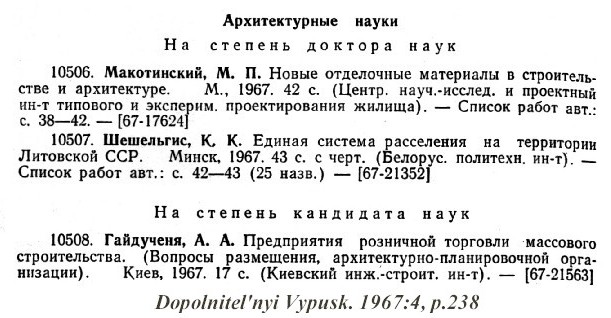
This supplement to the main series of the national bibliography lists all dissertations in the Soviet Union and Russian Federation. Since these are not “published” materials, originally they were not included in Knizhnaia letopis’. In 1938 a new publication appeared entitled Ezhegodnik dissertatsii 1936 god (U of I Library Call number: Main Stacks FILM 013 EZ39). From 1941 through 1945 dissertations could be found in Voinov’s register of dissertations at the State Library Bibliografiia dissertatsii. Doktorskie dissertatsii za 1941-1944 (Moscow: Gos. b-ka SSSR im. Lenina, 1946, Uof I Library Call number: Main Stacks FILM 013 M851B). From 1955 till 1960, dissertations were listed in a special section of the main series of Knizhnaia letopis’. From that point on they were included in the supplement to the main series, initially in Dopolnitel’nyi vypusk and later in separately published supplement devoted exclusively to dissertations. The western reader will immediately notice what appears to be the very brief pagination for the dissertations listed here. In fact, what are cited are abstracts to the dissertations, not the dissertations themselves. Dopolnitel’nyi vypusk and Letopis’ avtoreferatov dissertatsii are arranged by subject, following the scheme set up in Knizhnaia letopis’. Since its appearance, the bibliography has been issued monthly.
Letopis’ retsenzii.
Moscow: Knizhnaia Palata. 1935-
U of I Library Call Number: International & Area Studies Russian Reference (Slavic) 015.47 L56 (1935- )
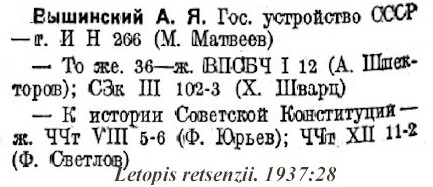
Since 1935 this useful index has been issued by Knizhnaia Palata. The title has varied over the years, appearing as Bibliografiia retsenzii from 1939 to 1941. The index listed reviews from journals, periodicals and newspapers from all over the Soviet Union. Up to 1977 the index appeared quarterly. After that time it was issued monthly. The index was not published from 1941 to 1945. Originally, entries were organized by author. Later they would follow a subject organization similar to that to Knizhnaia letopis’. Articles are drawn from a broad range of periodical sources.
Kartograficheskaia Letopis’.
Moscow: Knizhnaia Palata. 1931-
U of I Library Call Number: Main Stacks 016.5268 K149, 1951-1992
This publication lists maps published separately, in books, journals and collections. Before it began publication, separately published maps were listed in Knizhnaia letopis’ in the section entitled “Plakati i Listovki”. Maps were listed here in 1917-1918, 1920-1921, 1923-1925. In 1919, 1922, 1926-1930, individual maps were not registered with the Book Chamber and were, therefore, not included in Knizhnaia letopis’.
The bibliography is divided into two parts: maps and atlases. Maps are organized into general categories: maps of the world, parts of the world, countries. These categories are subdivided into subject areas: political and political-administrative maps, economic maps, geographic maps, physical maps, with historical maps listed last. Atlases are divided into two sections scientific atlases and school atlases. They are further grouped by region or continent.
Beginning in 1934, the index included publications about maps. Initially, this appeared at the end of issues 3 and 4. After 1939, it would become a regular part of the publication.
Bibliograficheskii ezhegodnik.
I. V. Vladislavlev (ed.). Moscow: “Nauka . 1911-13, 1921-24.
U of I Library Call number: Main Stacks, Main Stacks Reference 015.47 B471, 1911-1913, 1921-1924
Ezhegodnik gosudarstvennoi tsentral’noi knizhnoi palaty RSFSR .
Moscow:Gos. izd, 1927-1931.
U of I Library Call Number: Russian Reference 015.47 B471, 1927-1931
Ezhegodnik knigi SSSR. Sistematicheskii ukazatel’.
M. Vsesoiuz. knizhnaia palata, 1946-1992
U of I Library Call Number: Main Stacks, Main Stacks Reference, and Oak Street Facility 015.47 Ez3
Knigi Rossiiskoi Federatsii. Ezhegodnik.
Moscow: “Buk Chember Interneshnl”. 1994-
U of I Library Call Number: Oak Street Facility 015.47 EZ311; Recent volumes in International & Area Studies Russian Reference (Slavic).
Beginning in 1911 with Vladislavlev, a subject list of Russia’s publications was available. The early publication, Bibliograficheskii ezhegodnik, included articles from journals and reviews. Like its successors, the volumes included extensive indexes with entries organized by subject in the body of the bibliography.
The next incarnation of this publication was Ezhegodnik gosudarstvennoi tsentral’noi knizhnoi palaty RSFSR. It was published from 1927 to 1931 and covered the publications issued between 1925 and 1929. Articles were no longer included. The author index remained as did the subject organization.
Ezhegodnik knigi SSSR began publication in 1936. In 1943 the publication was issued in two volumes. Beginning in 1957 each volume was devoted to a different set of disciplines. One included the sciences, the other was devoted to the social sciences and humanities. The volume was organized mirroring that of the national bibliography. However, it was far more “user-friendly” with its numerous indexes and annual compilation. Instead of having to search quarterly indexes, three compiled indexes for each year are available. For each year there was a name index, a title index and a subject index. So why would anyone use Knizhnaia letopis’ ? There is a difference in the content of the two publications. Knizhnaia letopis’ includes every publication that was registered in the Soviet Union. Ezhegodnik knigi includes the entries from the main series of Knizhnaia letopis’. Items listed in the supplements are not included. There is also an index of books by language, often a useful tool for those studying the various nationalities in the Soviet Union.
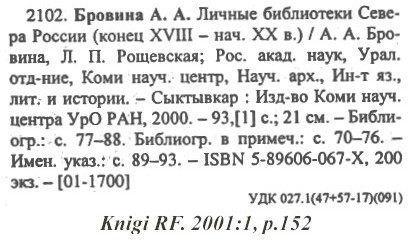
In its newest form, Knigi Rossiiskoi Federatsii, this bibliography has been expanded. The 2002 bibliography is comprised of 9 volumes. It has continued to follow the organization of Knizhnaia letopis’ and is therefore now organized in categories similar, though not identical, to our Dewey decimal categories. The same extensive indexing exists. Another distinction between the two bibliographies is the inclusion of subject headings in the entries in Knizhnaia letopis’. While the entries in Knigi RF are accessible through the subject index the entries do not include the subject headings.
